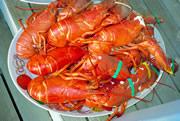 Lobster was once served to servants, but is now a pricey platter.© Alamy
Lobster was once served to servants, but is now a pricey platter.© AlamyFisheries experts are using old restaurant menus to piece together how the world's seafood stocks have declined over the past century and a half. Prices dating back to the 1850s highlight the growing scarcity of foods such as lobster, swordfish and oysters.
The approach, part of a project called the History of Marine Animal Populations (HMAP), is one of a series of methods devised to collect clues to how humans have depleted a range of ocean species. The ten-year programme is drawing on sources such as monastery records of fishing hauls, taxes paid by fishermen to landowners, and even the discarded papers of an Australian trawler company, retrieved from a rubbish dump.
“With lobster, availability and fashionability are two opposing trends.”
Poul Holm
History of Marine Animal Populations project
The restaurant study looks at data from some 10,000 archived restaurant menus in traditional US seafood towns such as Boston, San Francisco and Providence in Rhode Island. After adjusting for inflation, the rises in price of delicacies such as oysters reflect their growing scarcity as fishermen strive to keep up with demand, the researchers argue.
Restaurant prices are influenced by other factors besides fish availability, such as the Great Depression that kept prices relatively low throughout the 1930s. But the results broadly reflect the availability of many species, which in turn is influenced by their natural population levels in the wild, claims HMAP project leader Poul Holm of the University of Southern Denmark, Esbjerg.
In hot water
One particularly striking example is lobster, says Holm. During the mid-to-late 1800s, these crustaceans were mostly eaten by servants. But during the twentieth century, as they became harder to catch, they gradually acquired their current desirable status. "With lobster, availability and fashionability are two opposing trends," Holm says.
Prices have risen as declining stocks mean that catching seafood requires more and more effort, Holm explains. "It's a question of emptying the coastal seas and then going for global stocks wherever they remain," he says.
That is certainly true in the case of abalone, a prized but slow-growing mollusc. From the 1920s through to the 1940s, the researchers found, the dish was priced at around US$7 in today's prices. But a population crash led to a ban on abalone fishing in southern California in 1997, and imported abalone is now priced at between $50 and $70 for those Californians who can afford it.
The ultimate aim of the HMAP survey is to work out which species have thrived over the years and which ones have been driven to the brink by overfishing. One fish that has escaped severe population pressure is North Sea herring (Clupea harengus), for which catches have been stable for some 400 years, Holm says.
Chips are down
The survey's results, which will be presented this week at the Oceans Past conference in Kolding, Denmark, come as other researchers are calling for an almost complete ban on fishing in many of the world's hardest-hit areas, such as the North Sea.
Researchers from the International Council for the Exploration of the Sea, based in Copenhagen, are advising that fishing activities in many regions of the world's oceans be reduced to zero for the sake of endangered fish. These creatures include many food species, such as the orange roughy (Hoplostethus atlanticus) and roundnose grenadier (Coryphaenoides rupestris), but also deepwater sharks that are often snared as by-catch, such as the Portuguese dogfish (Centroscymnus coelolepis).
ADVERTISEMENT
"The only way to do it is to reset the watch," argues Poul Degnbol, chairman of the council's advisory committee on fishery management. "We have to start from a low level and monitor closely. We can only expand when we know what we're doing."
Working out how many fish we can take without causing a population crash is a priority for fisheries researchers, adds Holm. And until we have that knowledge, fishing has to be cut back to more modest levels, he argues.
"We're kidding ourselves if we think we will ever have a perfect knowledge," he says. "But we're balancing on the edge of the cliff, and it would be much wiser for us just to take a few steps back."
History of Marine Animal Populations project
